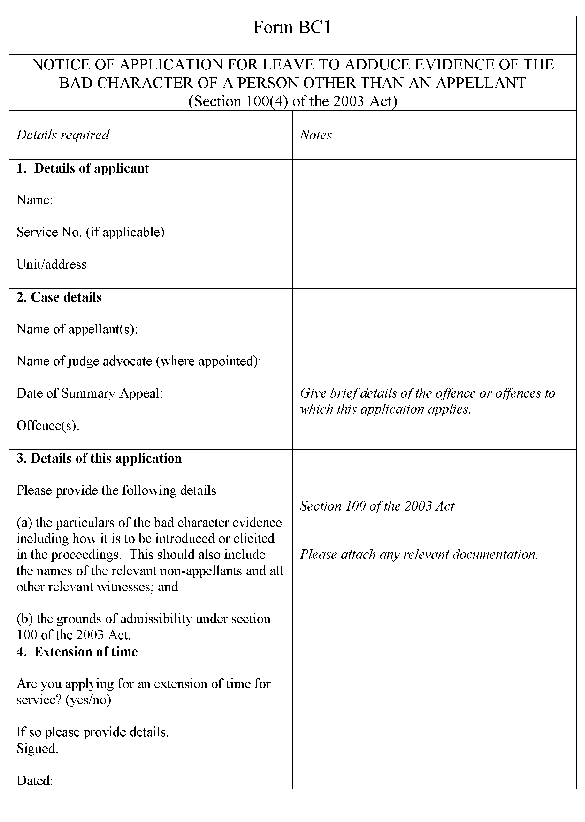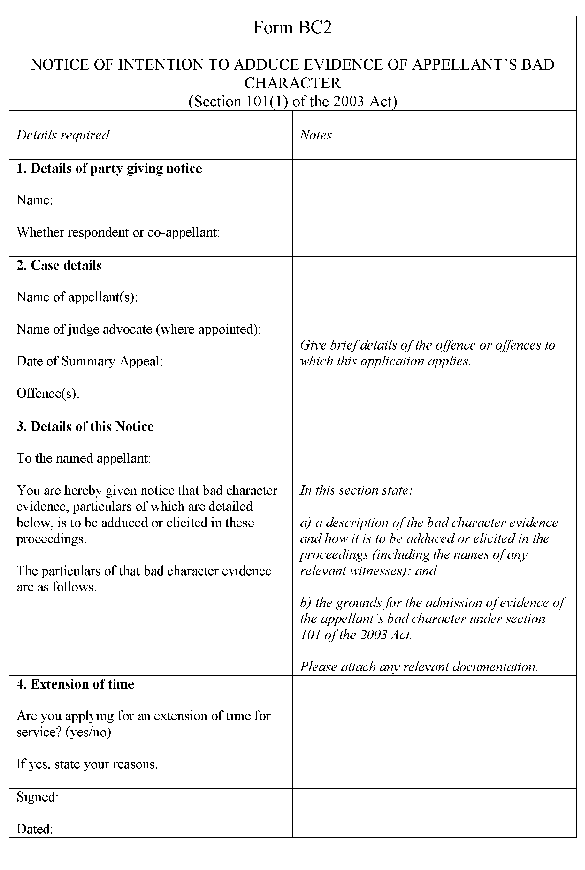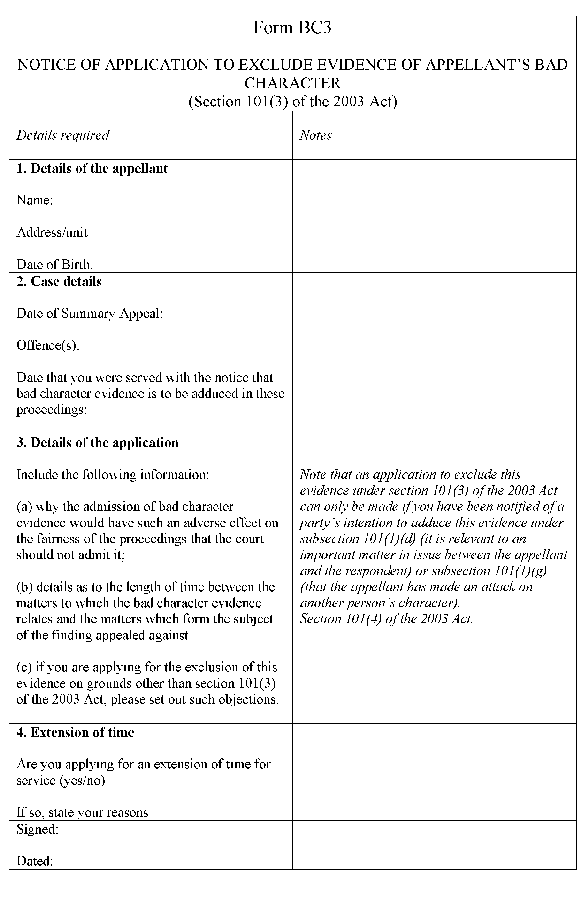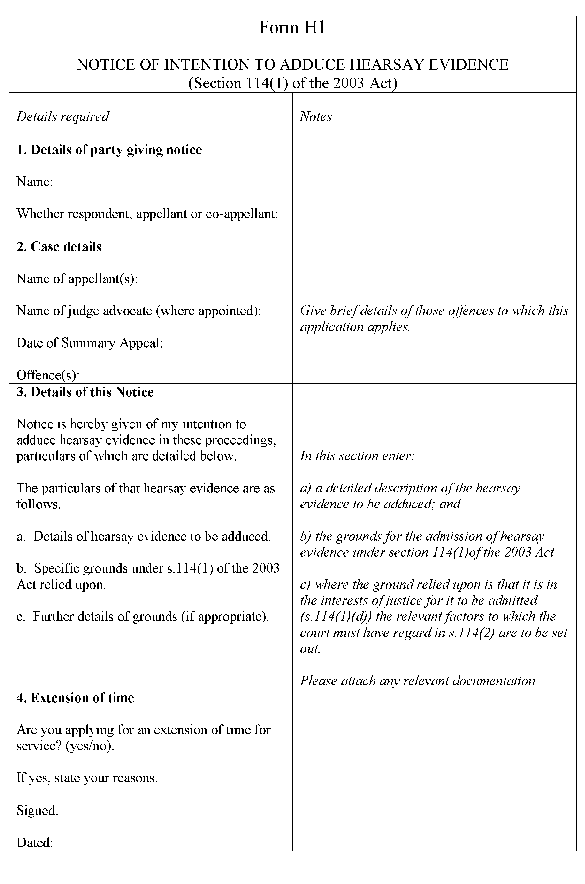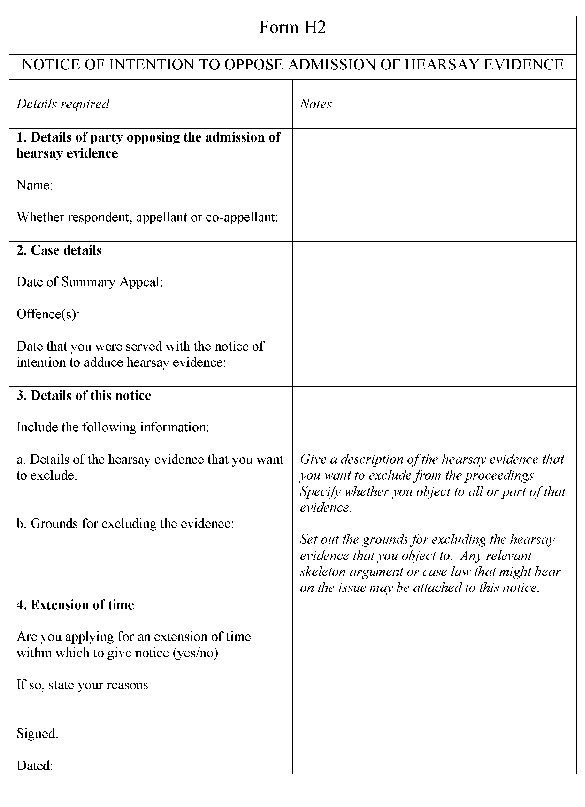Statutory Instruments
2005 No. 1536
DEFENCE
The Summary Appeal Courts (Amendment) Rules 2005
Made
8 June 2005
Laid before Parliament
10 June 2005
Coming into force
1 July 2005
Citation, commencement and interpretation
1.—(1) These Rules may be cited as the Summary Appeal Courts (Amendment) Rules 2005 and shall come into force on 1 July 2005.
(2) In these Rules—
“the Army Rules” means the Summary Appeal Court (Army) Rules 2000(5);
“the Air Force Rules” means the Summary Appeal Court (Air Force) Rules 2000(6); and
“the Navy Rules” means the Summary Appeal Court (Navy) Rules 2000(7).
Amendments to the Army Rules, the Air Force Rules and the Navy Rules
2.—(1) The Army Rules, the Air Force Rules and the Navy Rules are amended as follows.
(2) In rule 2(1) after the definition of “the Act” there is inserted—
““the 2003 Act” means the Criminal Justice Act 2003;”
(3) After rule 29 there is inserted—
“Procedure for the admission of evidence of bad character
29A.—(1) Where a party to the proceedings wishes to obtain the leave of the court under section 100(4) of the 2003 Act to adduce evidence of the bad character of a person other than an appellant, he shall apply in the form set out in Schedule 2 and the application must be received by the court administration officer and all other parties to the proceedings—
(a)where that party is an appellant or co-appellant, not more than 7 days after service on him of the respondent’s papers by his commanding officer in accordance with rule 18(3); or
(b)where that party is the respondent, not more than 7 days after he has given notice of his intention to contest an appeal against finding in accordance with rule 16(1); or
(c)where the application concerns a person other than an appellant who is invited to give (or has given) evidence for an appellant, as soon as reasonably practicable.
(2) A party to the proceedings who receives a copy of an application under paragraph (1) may oppose that application by giving notice in writing to the court administration officer and all other parties to the proceedings not more than 7 days after receiving that application.
(3) Where a respondent wishes to adduce evidence of an appellant’s bad character he shall give notice in the form set out in Schedule 2 to the court administration officer and all other parties to the proceedings not more than 7 days after he has given notice of his intention to contest an appeal against finding in accordance with rule 16(1).
(4) Where a co-appellant wishes to adduce evidence of an appellant’s bad character he shall give notice in the form set out in Schedule 2 to the court administration officer and all other parties to the proceedings not more than 7 days after service on him of the respondent’s papers by his commanding officer in accordance with rule 18(3).
(5) Where an appellant wishes to apply under section 101(3) of the 2003 Act to exclude evidence of his bad character he shall apply in the form set out in Schedule 2 and the application must be received by the court administration officer and all other parties to the proceedings not more than 7 days after the appellant receives a notice under paragraph (3) or (4).
(6) An appellant entitled to receive a notice under this rule may waive his entitlement by so informing the court administration officer and the party who would otherwise have given the notice.
(7) The judge advocate may—
(a)allow a notice or application required under this rule to be given or made in a different form, or orally; or
(b)reduce a time limit under this rule, or extend it whether or not it has expired,
if it is in the interests of justice to do so.
(8) Where this rule requires a notice or application to be given or made it may be given or made by fax or other means of electronic communication.
Procedure for the admission of hearsay evidence
29B.—(1) Where a party to the proceedings wishes to adduce hearsay evidence on one or more of the grounds in section 114(1) of the 2003 Act, he shall give notice in the form set out in Schedule 2 and such notice must be received by the court administration officer and all other parties to the proceedings—
(a)where that party is an appellant or co-appellant, not more than 7 days after service on him of the respondent’s papers by his commanding officer in accordance with rule 18(3); or
(b)where that party is the respondent, not more than 7 days after he has given notice of his intention to contest an appeal against finding in accordance with rule 16(1).
(2) A party to the proceedings who receives a notice under paragraph (1) may oppose the admission of the hearsay evidence by giving notice in the form set out in Schedule 2 to the court administration officer and all other parties to the proceedings not more than 7 days after receiving that notice.
(3) A party entitled to receive a notice under this rule may waive his entitlement by so informing the court administration officer and the party who would otherwise have given the notice.
(4) The judge advocate may—
(a)dispense with the requirement to give notice of an intention to adduce hearsay evidence;
(b)allow a notice required under this rule to be given in a different form, or orally; or
(c)reduce a time limit under this rule, or extend it whether or not it has expired,
if it is in the interests of justice to do so.
(5) Where this rule requires a notice to be given it may be given by fax or other means of electronic communication.
Application of rules 29A and 29B
29C. Rules 29A and 29B shall only apply in relation to proceedings in which no notice of intention to contest an appeal against finding has been given by the respondent in accordance with rule 16(1) before 1 July 2005.”.
Forms relating to the admission of evidence of bad character
3.—(1) In Schedule 2 to each of the Army Rules and Air Force Rules, after “Rules 8(1), 9(2), 12(2), 15(2)” there is inserted “, 29A(1), (3), (4) and (5), 29B(1) and (2)”.
(2) In Schedule 2 to the Navy Rules, after “Rules 8(1), 9(2) and (3), 12(2) and (3), 15(2)” there is inserted “, 29A(1), (3), (4) and (5), 29B(1) and (2)”.
(3) In Schedule 2 to each of the Army Rules, Air Force Rules and Navy Rules, before “Form 1—Notice of appeal” there is inserted—
“Form BC1—Notice of application for leave to adduce evidence of the bad character of a person other than an appellant
Form BC2—Notice of intention to adduce evidence of appellant’s bad character
Form BC3—Notice of application to exclude evidence of appellant’s bad character
Form H1—Notice of intention to adduce hearsay evidence
Form H2—Notice of intention to oppose admission of hearsay evidence”.
(4) The forms set out in the Schedule to these Rules are inserted before Form 1 in Schedule 2 to each of the Army Rules, Air Force Rules and Navy Rules.
Don Touhig
Parliamentary Under Secretary of State Ministry of Defence
8 June 2005
Rule 3
SCHEDULE 1
Explanatory Note
(This note is not part of the Rules)
These Rules amend the Summary Appeal Court (Army) Rules 2000, the Summary Appeal Court (Air Force) Rules 2000 and the Summary Appeal Court (Navy) Rules 2000 (“the Summary Appeal Court Rules”). Rule 2(3) inserts new rules into each of the Summary Appeal Court Rules to provide for the procedure for the admission of evidence of bad character and hearsay evidence under Chapters 1 and 2 of Part 11 of the Criminal Justice Act 2003. By virtue respectively of section 113 and Schedule 6, and section 135 and Schedule 7, of that Act, Chapters 1 and 2 have effect, subject to modification, in relation to proceedings before summary appeal courts. Rule 3 of these Rules inserts the forms relating to the admission of evidence of bad character and hearsay evidence into each of the Summary Appeal Court Rules. The new rules only apply to proceedings in relation to which the respondent gives notice of an intention to contest an appeal against finding on or after 1 July 2005.
2003 c. 44: by virtue of section 113 of, and paragraph 5 of Schedule 6 to, the Criminal Justice Act 2003 (“the 2003 Act”), section 111 has effect as if, in subsection (7), the definition of “rules of court” included rules regulating the practice and procedure of service courts. By virtue of section 135 of, and paragraph 2(6) of Schedule 7 to, the 2003 Act, section 132 is modified so that in its subsection (10), the definition of “rules of court” includes rules regulating the practice and procedure of service courts. By virtue of paragraph 6 of Schedule 6 and paragraph 8 of Schedule 7, “service court” includes a summary appeal court and “summary appeal court” means a summary appeal court constituted under the Army Act 1955, the Air Force Act 1955 or the Naval Discipline Act 1957.
